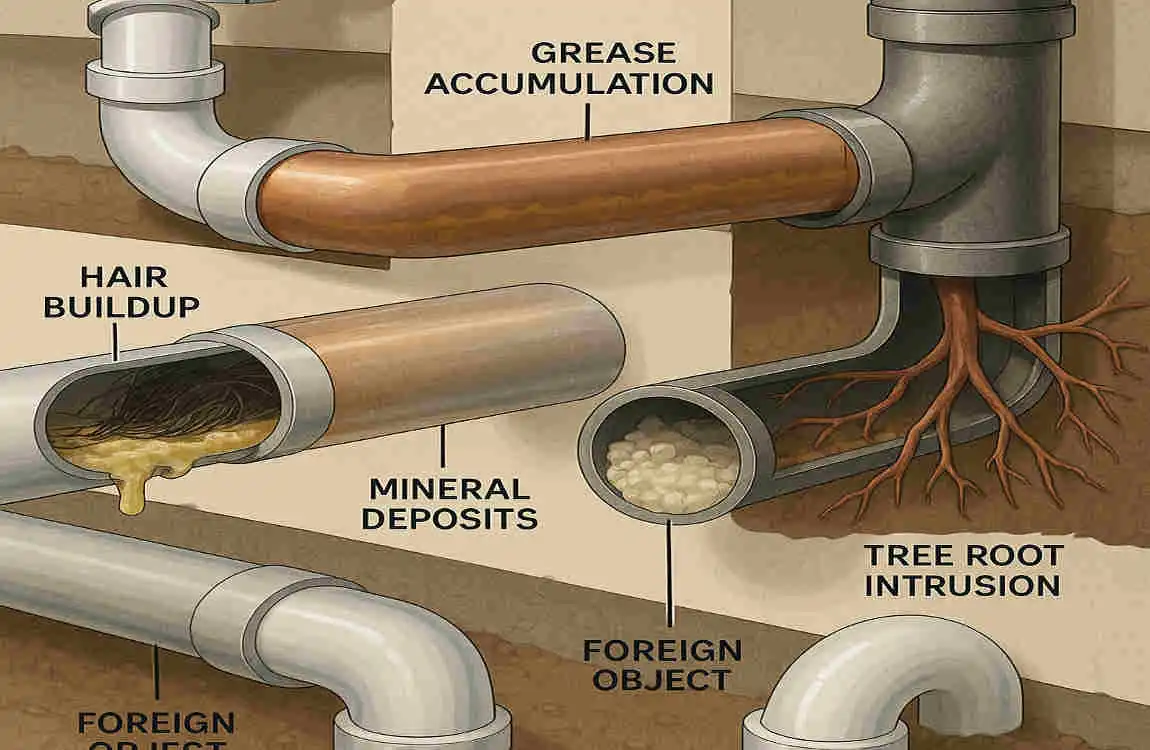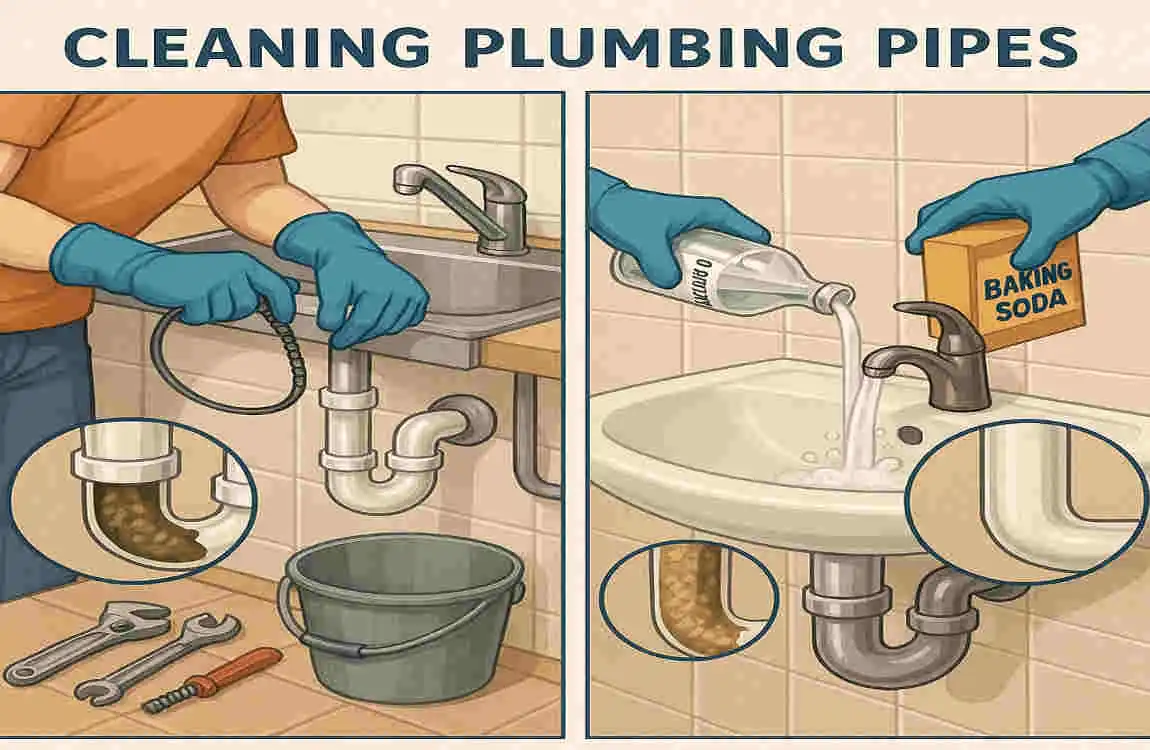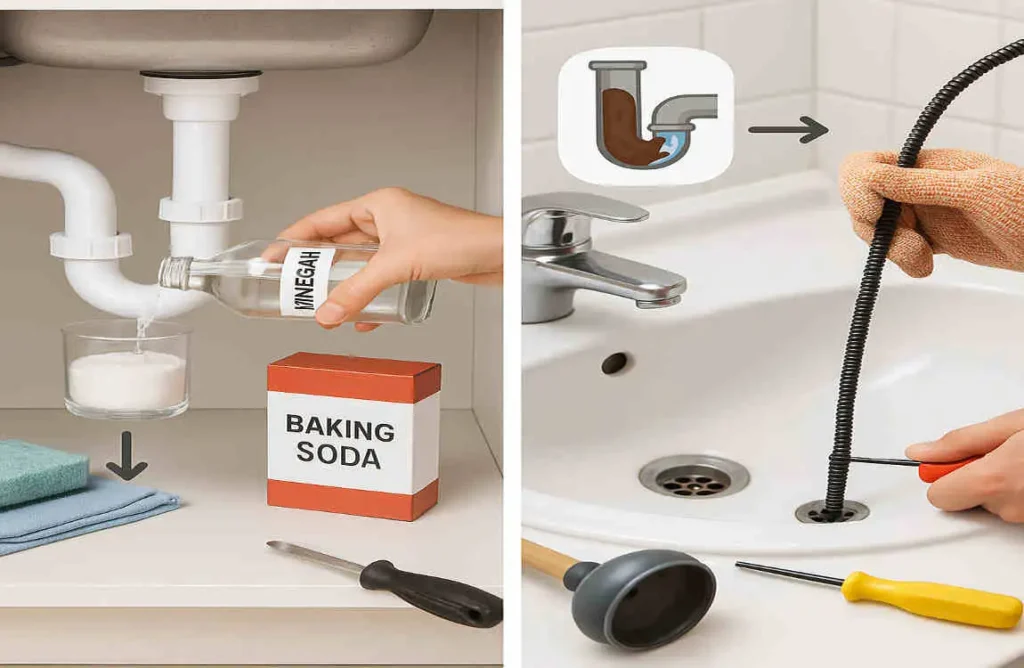Have you ever stood in the shower, only to find yourself ankle-deep in water because of a slow drain? Or you may have noticed a strange odour coming from your kitchen sink. These are signs that your plumbing pipes might need some attention. Clogged or dirty pipes can lead to a host of issues, from slow drainage to complete backups. But don’t worry, you don’t need to call a plumber just yet.
Maintaining your plumbing system in good condition is crucial for a smoothly running household. By learning how to clean your pipes at home, you can save money on professional services and prevent more serious issues down the line.
Understanding Plumbing Pipes and Common Clog Causes

Before we get into the nitty-gritty of cleaning your pipes, it’s helpful to understand what you’re dealing with. Plumbing pipes come in various materials, each with its own characteristics:
- PVC (Polyvinyl Chloride): Lightweight, durable, and resistant to corrosion.
- Copper: Long-lasting and resistant to bacterial growth, but can corrode over time.
- Galvanised Steel: Strong and affordable, but prone to rust and mineral buildup.
Now, let’s talk about what can cause those pesky clogs:
- Debris, such as hair, soap scum, and other particles, can accumulate and form clogs.
- Grease: Cooking oils and fats can solidify in pipes, causing blockages.
- Mineral Buildup: Hard water can leave behind mineral deposits that narrow pipe openings, potentially causing blockages.
- Rust: Over time, certain pipe materials can corrode, leading to reduced flow.
How do you know if your pipes need to be cleaned? Keep an eye out for these signs:
- Slow Drainage: Water takes longer than usual to drain.
- Bad Odours: Foul smells emanating from your sinks or drains.
- Gurgling Sounds: Unusual noises coming from your plumbing system.
Safety Precautions Before Cleaning Plumbing Pipes
Before you start tackling those clogs, it’s important to take some safety measures. After all, you want to keep yourself and your home safe while getting the job done.
First and foremost, turn off the water supply to the area where you’ll be working. This will prevent any accidental spills or flooding. It’s also a good idea to wear protective gloves and eyewear to shield your skin and eyes from any debris or cleaning solutions.
When it comes to cleaning products, avoid using harsh chemicals whenever possible. These can be harmful to your pipes, the environment, and your health. If you do decide to use a chemical drain cleaner, always follow the instructions carefully and use it in a well-ventilated area.
Remember, if you’re unsure about anything or if the clog seems particularly stubborn, don’t hesitate to call a professional plumber. They possess the tools and expertise to handle even the most challenging blockages.
DIY Methods on How to Clean Plumbing Pipes at Home

Now, let’s get to the good stuff – the DIY methods you can use to clean your plumbing pipes at home. We’ll cover mechanical techniques, natural and eco-friendly solutions, commercial products, and preventive maintenance tips.
Mechanical Cleaning Techniques
Sometimes, all you need is a bit of elbow grease to get things flowing again. Here are some mechanical methods you can try:
Using a Plunger Effectively for Minor Clogs
The trusty plunger is a staple in every home’s plumbing toolkit. To use it effectively:
- Fill the sink or bathtub with enough water to cover the bell of the plunger.
- Place the plunger over the drain and ensure a tight seal is formed.
- Push and pull the plunger vigorously to create suction and dislodge the clog.
- Continue until the water drains freely.
How to Use a Plumbing Snake (Auger) Step-by-Step
For more stubborn clogs, a plumbing snake (also known as an auger) can be a lifesaver. Here’s how to use one:
- Insert the snake into the drain until you feel resistance.
- Rotate the handle clockwise to break up the clog.
- Once the clog is dislodged, pull the snake out of the drain.
- Run hot water down the drain to flush out any remaining debris.
Wire Hanger Alternative for Pulling Out Clogs
If you don’t have a plunger or snake on hand, a simple wire hanger can do the trick:
- Straighten out a wire hanger, leaving a small hook at one end.
- Insert the hooked end into the drain and fish around for the clog.
- Once you’ve snagged the clog, pull it out slowly.
- Run hot water down the drain to clear any remaining debris.
Natural and Eco-Friendly Cleaning Solutions
If you prefer a more environmentally friendly approach, these natural solutions can help keep your pipes clean:
Baking Soda and Vinegar Method: Steps and Benefits
This classic combination is a powerhouse when it comes to cleaning pipes:
- Pour 1/2 cup of baking soda down the drain.
- Follow it with 1 cup of white vinegar.
- Cover the drain and let the mixture fizz and work its magic for about 30 minutes.
- Flush the drain with hot water.
The benefits of this method include:
- Eco-friendly: No harsh chemicals involved.
- Safe for pipes: Won’t harm your plumbing system.
- Deodorising: Helps eliminate foul odours from your drains.
Using Hot Water and Dish Soap for Grease Buildup
Grease can be a tricky culprit when it comes to clogs, but hot water and dish soap can help:
- Boil a pot of water.
- Add a few squirts of dish soap to the boiling water.
- Carefully pour the mixture down the drain.
- Let it sit for a few minutes before flushing with more hot water.
This method works because:
- Hot water: Helps melt and dissolve grease.
- Dish soap: Breaks down grease and prevents it from sticking to pipes.
Lemon Juice and Salt Combination to Deodorise and Clean Pipes
For a refreshing and effective cleaning solution, try this lemon juice and salt combo:
- Mix 1/2 cup of lemon juice with 1/2 cup of salt.
- Pour the mixture down the drain.
- Let it sit for about 30 minutes.
- Flush the drain with hot water.
The benefits of this method include:
- Deodorising: Lemon juice helps neutralise unpleasant odours.
- Scrubbing action: Salt acts as a gentle abrasive to scrub away debris.
- Natural and safe: No harsh chemicals involved.
Commercial Cleaning Products
If you prefer to use a commercial product, numerous options are available. Here’s what you need to know:
Overview of Available Pipe Cleaning Products
From liquid drain cleaners to foaming agents, a wide range of products is available on the market. Some popular options include:
- Liquid drain cleaners: Typically contain strong chemicals to dissolve clogs.
- Foaming drain cleaners: Expand to fill the pipe and break down clogs.
- Enzyme-based cleaners: Use natural enzymes to break down organic matter.
How to Safely Use Chemical Drain Cleaners if Necessary
If you decide to use a chemical drain cleaner, follow these safety precautions:
- Always read and follow the instructions on the product label.
- Wear protective gloves and eyewear.
- Use in a well-ventilated area.
- Never mix different types of drain cleaners.
- Flush the drain thoroughly with water after use.
Pros and Cons of Commercial Products Compared to Natural Solutions
Here’s a quick comparison of commercial products and natural solutions:
Commercial Products Natural Solutions
Pros – Often faster acting- Can tackle stubborn clogs – Eco-friendly- Safe for pipes- Cost-effective.
Cons: Can be harmful to pipes and the environment. May contain harsh chemicals. It may require more time and effort, and may not always be effective for severe clogs.
Preventive Maintenance Tips
The best way to keep your pipes clog-free is to practice regular preventive maintenance. Here are some tips to help you stay on top of things:
- Regularly Flush Pipes with Hot Water or Vinegar: Once a month, pour boiling water or a mixture of hot water and vinegar down your drains to keep them clear.
- Avoid Pouring Grease or Food Scraps Down the Drain: Dispose of grease in the trash and use a garbage disposal sparingly.
- Install Mesh Drain Covers: These can help catch hair and debris before they enter your pipes, preventing clogs.
When to Call a Professional Plumber
While DIY methods can be effective for many clogs, there are times when it’s best to call in a professional. Here are some warning signs that you may need a plumber’s help:
- Persistent Clogs: If you’ve tried multiple DIY methods and the clog keeps coming back, it may be a sign of a more serious issue.
- Slow Drainage Throughout the House: If multiple drains are affected, it could indicate a problem with your main sewer line.
- Sewage Backup: If you notice sewage backing up into your home, call a plumber immediately.
Ignoring severe clogs or damaged pipes can lead to more serious issues, such as burst pipes or water damage. A professional plumber can diagnose the problem and provide the necessary repairs to keep your plumbing system running smoothly.
